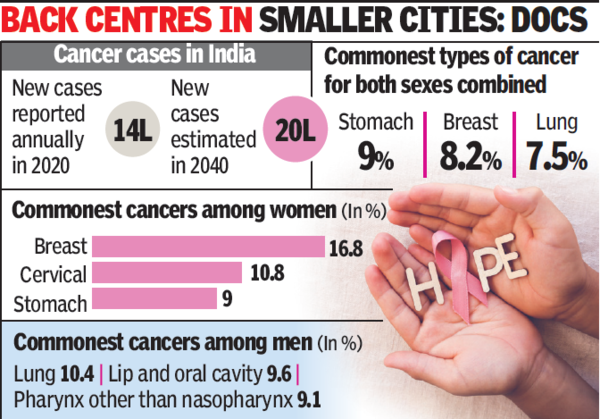[ad_1]
This worrying projection was a central focus on the opening day of the Indian Cancer Congress (ICC) at BKC on Thursday, where specialists underscored the urgency of expanding infrastructure and medical workforce to tackle the growing burden of the disease. The ICC, convening once every four years, has drawn over 5,000 delegates from diverse oncology fields.
Data shows that some of the highest cancer incidence rates in India continue to be concentrated in the Northeastern states. Aizawl, the capital of Mizoram, reports the highest cancer incidence among men, at 269.4 per 100,000 population, while the Papumpare district of Arunachal Pradesh records the highest incidence among women. However, with few exceptions, even the largest metropolitan areas are maintaining cancer incidence rates within the range of 100-110 per 100,000. For instance, Mumbai’s male cancer incidence rate currently stands at 108 per 100,000 and females at 116, a figure that has remained relatively stable since 2001.

Dr Rajendra Badwe, Director of Tata Memorial Centre, said India indeed hasn’t experienced the same rise as the West or BRICS countries like Russia and South Africa. “It could be because of our approach of not pursuing extensive screening for all types of cancers but the strategic focus on screening for the three main cancers: Oral, breast, and cervical,” he said.
Dr Rajesh Dikshit, the head of cancer epidemiology at Tata, drew comparisons between India and the UK and Canada, where cancer incidence rates are higher (300-350 per 1,00,000). He pointed out that while India’s overall cancer incidence remains stable, there are notable micro-level variations. Like cervical cancer rates that have seen a sharp decline in India, reaching as low as 7-8 per 1,00,000, are in contrast with breast, lung, and oral cancer that continue to rise sharply. Additionally, cervical cancer incidence may be decreasing, but a high mortality rate prevails.
Dr Sanjay Sharma, Chairman of the ICC, stressed that even if the incidence rate remains unchanged, the increase in absolute numbers is placing a significant burden on healthcare facilities. He recommended that the government subsidize the private sector in establishing more cancer hospitals. Dr Badwe added that TMC has created nine new cancer hospitals and will add six more. He said he was hopeful that India will have enough cancer centres by 2033.
The shortage of cancer experts in bigger cities is now well addressed with India producing nearly 1500 experts catering to various branches of oncology, said Dr Shripad Banavali of TMC. However, to support the growth of cancer centres in smaller cities, doctors will also need to relocate to these areas.
[ad_2]
Source link










More Stories
Congress replaces Kamal Nath, names an OBC as Madhya Pradesh chief | India News
Fire breaks out in ITBP camp in Srinagar; none hurt | India News
Parliament Security: Co-villagers give clean chit to Lalit Jha, parents to move court | India News